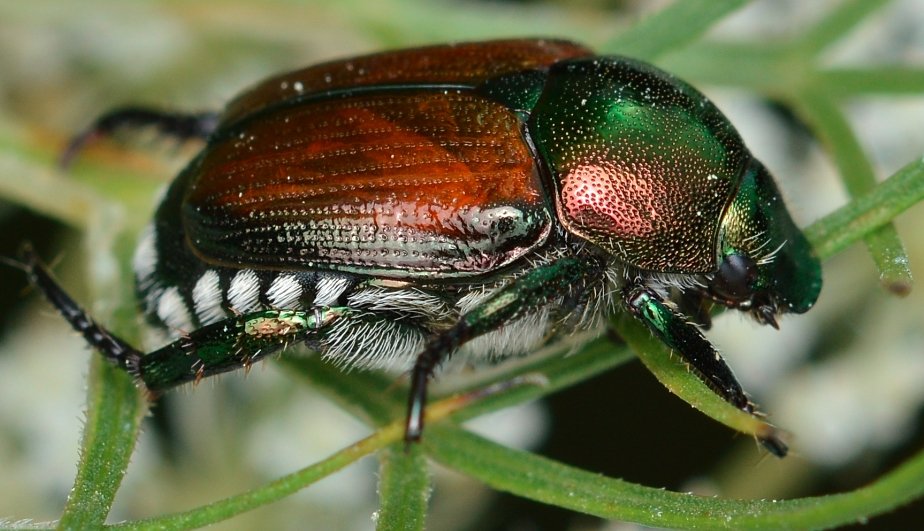The Japanese beetle is a destructive pest that can damage over 300 plant species, including turfgrass, roses, grapes, and fruit trees. The beetle was first detected in Grand Junction in 2022 and has since been declared a public nuisance by Mesa County commissioners. The county and the city of Grand Junction have embarked on a program to eradicate the beetle from Mesa County, but they need the help of residents and property owners to prevent its spread and impact.
What is the Japanese beetle and why is it a problem?
The Japanese beetle (Popillia japonica) is a metallic green and copper-colored insect that is native to Japan. It was accidentally introduced to the U.S. in 1916 and has since become established in most of the eastern and central states. The beetle feeds on the leaves, flowers, and fruits of many plants, leaving behind skeletonized or holey foliage. The beetle can also transmit diseases and fungi that can further weaken the plants.
The beetle has two life stages: the adult and the grub. The adult beetles emerge from the soil in late spring or early summer and fly up to two miles to find food and mates. They are most active on warm, sunny days and can be found in large aggregations on their host plants. The adult beetles live for about six weeks and lay eggs in the soil near their food sources.
The eggs hatch into white, C-shaped grubs that feed on the roots of grasses and other plants. The grubs overwinter in the soil and resume feeding in the spring. They pupate in late spring and emerge as adults in the summer. The grubs can cause significant damage to lawns, golf courses, and pastures by reducing the root mass and making the turf susceptible to drought and disease.

The Japanese beetle is a serious threat to Mesa County’s agriculture and horticulture industries, as well as to the aesthetic and environmental values of the area. The beetle can affect the quality and quantity of crops such as grapes, peaches, apples, cherries, and corn. It can also reduce the beauty and diversity of ornamental plants, gardens, and landscapes. The beetle has no natural predators or parasites in the U.S. and can quickly multiply and spread if left unchecked.
What is being done to control and eradicate the Japanese beetle in Mesa County?
Mesa County and the City of Grand Junction have been working together to implement an integrated pest management program to control and eradicate the Japanese beetle in Mesa County. The program involves the following components:
- Surveillance and mapping: The county and the city have been conducting annual surveys to monitor the distribution and population of the Japanese beetle in the area. They have been using pheromone traps and visual inspections to detect and locate the beetle infestations. They have also been mapping the infested areas and the treatment zones using geographic information systems (GIS).
- Treatment and eradication: The county and the city have been applying acelepryn, a safe and effective insecticide, to the infested properties and the surrounding buffer zones. Acelepryn is a granular product that is applied to the soil and watered in. It kills the grubs in the soil and prevents the emergence of the adult beetles. The county and the city have been treating the properties once a year, usually in April or May, before the adult beetles emerge. The treatment is done by licensed applicators and is free of charge to the property owners. The county and the city have been following the label directions and the environmental regulations to ensure the safety and efficacy of the treatment.
- Education and outreach: The county and the city have been providing education and outreach to the public and the stakeholders about the Japanese beetle and its management. They have been using various methods such as websites, brochures, flyers, newsletters, social media, press releases, radio interviews, and public meetings to inform and engage the community. They have also been collaborating with other agencies and organizations such as Colorado State University Extension, Colorado Department of Agriculture, USDA-APHIS, Western Colorado Horticultural Society, and Mesa County Pest Advisory Committee to coordinate and support the program.
The county and the city have made significant strides in reducing the Japanese beetle population in Mesa County. According to Mesa County, they have successfully treated over 1,200 properties with acelepryn, spanning an area as vast as 209 football fields. With annual strategic treatments, they are on track to reduce the beetle population by 25 to 30 percent yearly, aiming for total eradication in three to five years.
How can you help prevent and manage the Japanese beetle in Mesa County?
The county and the city need the cooperation and participation of the residents and property owners to prevent and manage the Japanese beetle in Mesa County. Here are some ways you can help:
- Allow access to your property for treatment: If your property is within the treatment zone, you will receive a notification letter from the county or the city before the treatment. Please allow access to your property for the treatment and follow the instructions on the letter. The treatment is free, safe, and effective and will help protect your lawn and plants from the beetle damage.
- Do not move plants or soil from infested areas: The Japanese beetle can hitchhike on plants or soil that are moved from infested areas. Do not move or share plants or soil from your property or from other infested areas. If you need to dispose of plant material that may be infested with the beetle, place it in a sealed plastic bag and throw it in the trash. Do not compost it or leave it in the open.
- Inspect and wash your vehicles and equipment: The Japanese beetle can also travel on vehicles and equipment that are used in infested areas. Inspect and wash your vehicles and equipment before leaving or entering an infested area. Pay special attention to the tires, wheel wells, grills, and undercarriages. Use a high-pressure hose or a car wash to remove any dirt or debris that may contain the beetle or its eggs.
- Hand-pick and destroy the adult beetles: If you see any adult beetles on your plants, you can hand-pick them and destroy them. The best time to do this is in the early morning or evening when the beetles are less active. You can drop them into a bucket of soapy water or alcohol to kill them. Do not squish them or leave them on the ground, as this may attract more beetles or spread diseases or fungi.
- Choose resistant plants for your landscape: Some plants are more resistant or less attractive to the Japanese beetle than others. You can choose plants that are less likely to be damaged by the beetle for your landscape. Some examples of resistant plants are boxwood, lilac, forsythia, juniper, spruce, and yucca. You can also consult with your local nursery or extension office for more suggestions.
The Japanese beetle is a destructive pest that can harm your lawn and crops. By following these tips, you can help prevent and manage the Japanese beetle in Mesa County and support the county and the city’s efforts to eradicate the beetle from the area.













